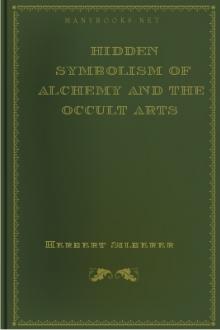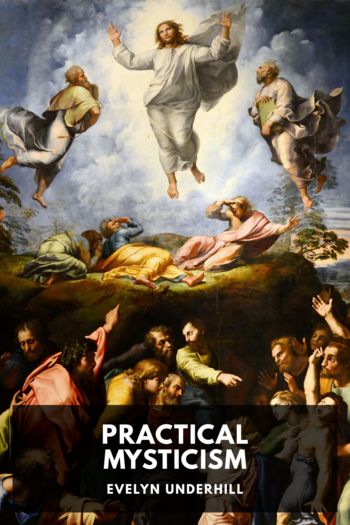Hidden Symbolism of Alchemy and the Occult Arts by Herbert Silberer (e book reader free .txt) 📕

- Author: Herbert Silberer
- Performer: -
Book online «Hidden Symbolism of Alchemy and the Occult Arts by Herbert Silberer (e book reader free .txt) 📕». Author Herbert Silberer
Alchemy was regarded by its disciples as a royal art. Old sources show that the art of making gold was revealed in Egypt only to the crown princes. [pg 196] Generally only the kings' sons were informed by the priests concerning the magic sciences. The hermetics derived their art expressly from kings, Hermes, Geber, and the patriarchs of alchemy were represented as kings.
According to Khunrath (Amphitheatrum) prayer, work and perseverance lead to eternal wisdom by the mystical ladder of the seven theosophical steps. Perfect wisdom consists in the knowledge of God and his Son, in the understanding of the holy scriptures, in self knowledge and in knowledge of the great world and its Son, the Magnesia of the philosophers or the Philosopher's Stone. The mystical steps in general contain three activities, hearing (audire), persevering (perseverare), knowing (nosse et scire), that applies to five objects, so that we can distinguish seven steps in all. Only the pure may enter the temple of wisdom, only the worthy are intrusted with the secrets, the profane, however, must stay away.
In the fifth table of Khunrath's Amphitheatrum is pictured the seven pillared citadel of Pallas (Prov. IX, 1). At the entrance is a table with the legend Opera bona (= good works). Behind sits a man with the staff of Mercury. On each side is a four sided pyramid, on the top of the left one is the sun, on the right the moon. On the former stands the word Fides (= faith), on the latter Taciturnitas (= silence). Behind the man we read the word Mysterion, over the inner entrance Non omnibus (= not for all).
[pg 197]Alchemy frequently mentions two or three lights. By these it understood [Symbol: Sol] and [Symbol: Luna], [Symbol: Venus], [Symbol: Mercury], [Symbol: Jupiter], light of grace and light of nature, etc. The juxtaposition of [Symbol: Sol] [Symbol: Luna] and [Symbol: Hexagram] is interesting; no one can attain the desired end before, through the circular wheel of the elements, the fatness or the blood of the sun, and the dew of the moon are by the action of art and nature, united in one body in the image of the hexagram; and this can take place only by the will of the Most High, who alone imparts the unique boon of the Holy Ghost and priceless treasure according to his especial mercy. The above mentioned circular wheel is identical with the serpent that bites its own tail; it is a power that always consumes and always renews itself. This circle appears not to be lacking in the flaming star; it is the round eye or the likewise round fashioned “G,” which latter looks quite similar to the snake hieroglyph. The reference to Genesis has a good reason. Moreover, the hexagram represents in cabbalistic sense the mystical union of the male with the female potence [Symbol: Fire] with [Symbol: Water]. According to a rabbinical belief a picture is supposed to be placed in the ark of the covenant alongside of the tables of the laws, which shows a man and a woman in intimate embrace, in the form of a hexagram. In cabbalistic writings, as for instance, in those of H. C. Agrippa, we find the human form in a star, generally inscribed in the pentagram. The genitals fall exactly in the middle part and are often made prominent by an added [Symbol: Mercury] as male-female or androgyne procreative power. One of the snake [pg 198] shaped Egyptian hieroglyphs frequently turns into an Arabic [Symbol: gimel], i.e., gimel. I do not know whether this fact has any significance here. With respect to the above passages that mention the “will of the Most High,” I refer to the dialogue which concerns the “G”; e.g., “Does it mean nothing else?” “Something that is greater than you.” “Who is greater than I?” etc. “It is Gott, whom the English call God. Consider this mysterious star; it is the symbol of the Spirit.... The image of the holy fire, etc.”
REBIS is represented as an hermetic hermaphrodite. The already mentioned figure with the two heads (figure 2) is found (as Höhler relates) in a book that appeared in Frankfort in 1618, called “Joannes Danielis Mylii Tractatus III, seu Basilica Philosophica,” though it is to be seen also in other books on alchemy. The hermaphrodite stands on a dragon that lies on a globe. In the right hand he holds a pair of compasses, in the left a square. On the globe we see a square and a triangle. Around the figure are the signs of the seven planets, with [Symbol: Mercury] at the top. In a cut in the Discursus Nobilis of John of Munster we see sun and moon, at the middle of the top the star [Symbol: Hexagram], also denoted by Y = γλζ (= matter) surrounded by rays. (Höhler, Herm. Phil., p. 105.)
In the cabala, which has found admission into the idea of the alchemists and rosicrucians, no small part is played by three pillars and two pillars.
Tubal Cain was renowned as a great alchemist. [pg 199] He was the patriarch of wisdom, a master of all kinds of brass and iron work. (Genesis IV, 22.) He had the knowledge not only of ordinary chemistry and of the fire required for it, but also of the higher chemistry and of the hidden elemental fire. After the flood there was no other man who knew the art but the righteous Noah, whom some call Hermogenes or Hermes, who possessed the knowledge of celestial and terrestrial things.
One devoted to art must be a free man (Höhler, l. c., p. 66). The ordinale of Norton establishes it more or less as follows: “The kings in the olden time have ordained that no one should learn the liberal sciences except the free and those of noble spirit, and any one who is devoted to them should devote his life most freely. Accordingly the ancients have called them the seven liberal arts, for whoever desires to learn thoroughly and well must enjoy a certain freedom.”
Very frequently one finds in the alchemists images of death: grave, coffin, skeleton, etc. Thus in Michael Maier's, Atalanta Fugiens, the Emblema XLIV shows how the king lies with his crown in the coffin which is just opened. On the right stands a man with a turban, on the left two who open the coffin and let his joyful countenance be seen. In the Practica of Basilius Valentinus the illustration of the fourth key shows a coffin, on which stands a skeleton, the illustration of the eighth key (see Fig. 3), a grave from which half emerges a man with upright body and raised hands. [This reproduction [pg 200] and figure I owe to the kindness of Dr. Ludwig Keller and the publications of the Comenius Society.] Two men are shooting at the well known mark, [Symbol: Sol], here represented as a target (a symbol much used in the old lodges), while a third is sowing. (Parable of the sower and the seeds.) The sign is a clever adaptation of the sulphur hieroglyph and is identical with the registry mark of the third degree of the Grand Lodge Indissolubilis. The mark [Symbol: Half circle] on the wall is also a symbol of the academy; it is the half circle, man, to whom the light is imparted and means, when occurring collectively, the fraternity. The evident idea is of representing the exclusive society as enclosing wall. The angel with the trumpet is the angel of the judgment day who awakes the dead. With respect to the birds I refer to Matthew XIII, 4: “And when he sowed, some seeds fell by the wayside and the fowls came and devoured them up.” In the text of Basilius Valentinus, the fourth key, there is mention of the rotting and falling to pieces with which we are familiar. The idea of dismemberment is not infrequently clearly expressed, more clearly than in our parable. Already in the oldest alchemistic manuals one operation is called the grave of Osiris. One of the manuscripts cited by Berthelot (Orig., p. 60) says: “The dragon is the guardian of the temple, sacrifice him, flay him, cut his flesh from his bones and thou wilt find what thou seekest.” The dragon is also called Osiris, with whose son Horus-Harpocrates, the skillful Hermes, is also identified. (Do we need [pg 201] reference to requirements in the 3d degree? J ... left his skin; ... B ... left his flesh...; M ... B..., he lives in the Son.)
Here more clearly than anywhere else we see the masonic symbolism combined with the myth of the first parents or creation myth. No matter where it acts, the myth-making power never seems willing to belie its laws. Also the tree growing out of the grave or the body of the dead ancestor is not wanting. (“... at the graves of our fathers.” “I was accused of a terrible crime.”) It is the acacia whose presence is rationalized apparently for the purpose of forming a sign by which to find again the place of the hastily buried.
An Egyptian fable tells of two brothers. The younger, Bata, was falsely accused by his sister-in-law (as was Joseph by Potiphar's wife). His brother Inpw (Anepu) consequently pursued him. The sun god made a mighty flood that separated the pursuer from the pursued. Bata castrated himself and threw his organ of generation into the water, where it was swallowed by a fish. Bata's heart later in the story is changed into a blossom of an acacia or a cedar. [I naturally lay no stress on the accident that the acacia occurs here. The point is that the tree is a symbol of life.] Bata is reconciled with Inpw and at parting relates to him that a mug of beer is to serve as a symbol of how the brother fares, who is dwelling afar off. If the beer foams he is in danger. Bata's wife has the acacia tree, on which Bata's heart is a blossom, felled, and as a [pg 202] result Bata dies. By means of the mug Inpw learns of Bata's peril and departs to look for his younger brother. Inpw finds the fallen acacia and on it a berry that is the heart of his brother transformed. Bata comes to life again and transforms himself into an ox. His wife has the ox butchered on the pretext of wishing to eat its liver. Two drops of blood fall from the cut throat of the ox upon the ground and are changed into two peach trees. Bata's wife has the two peach trees felled. A





Comments (0)